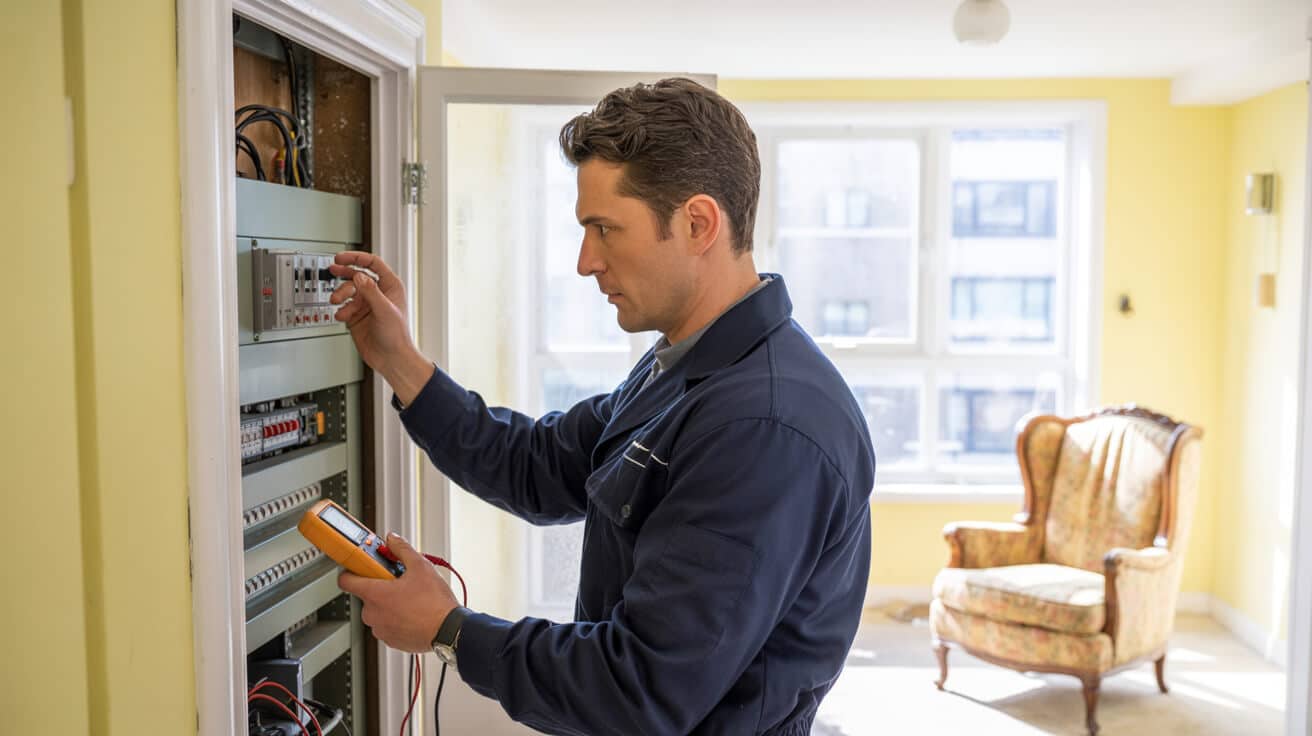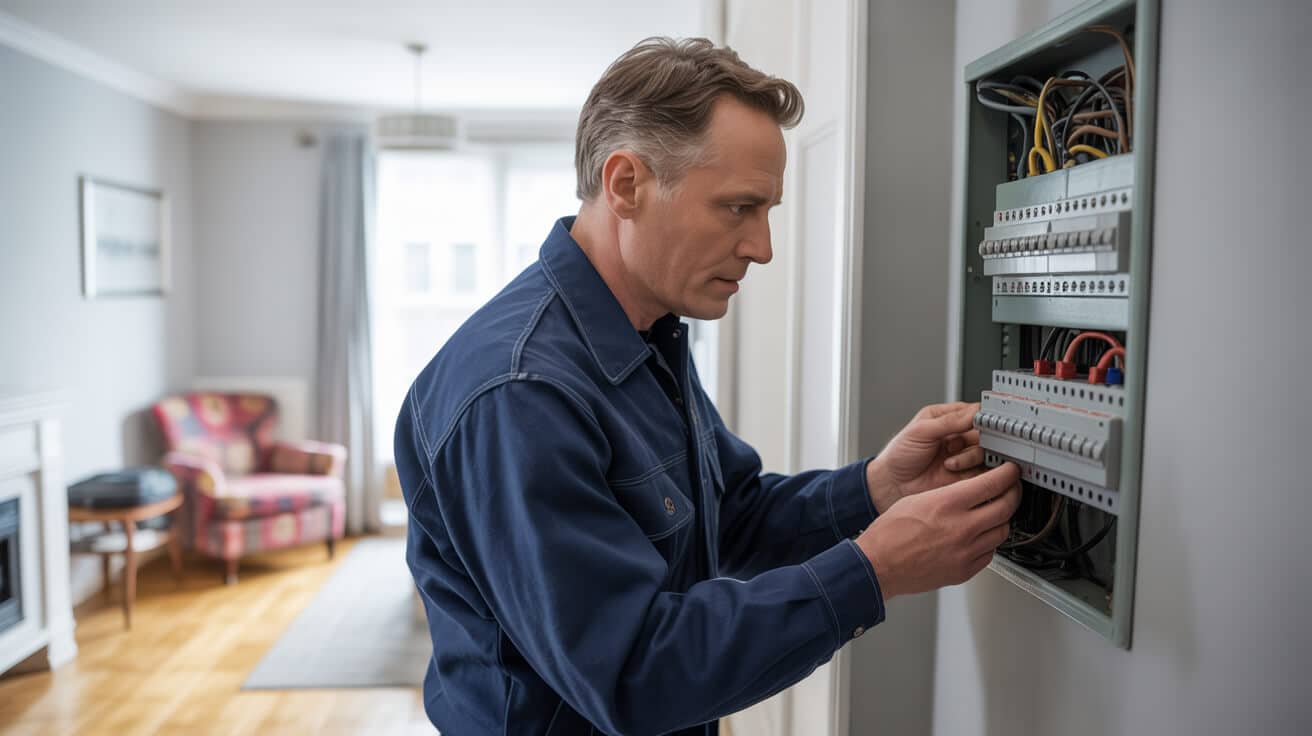 An Electrical Safety Checklist For Preventing Fire Hazards
An Electrical Safety Checklist For Preventing Fire Hazards

Is Your Electrical System Actually Safe—Or Just Untested?
You might trust your fire alarms and electrical system because they’ve “never failed,” but that confidence is misplaced if you haven’t checked the right details. Most property fires don’t erupt out of dramatic faults—they start with silent, trivial issues ignored for weeks or months. From overlooked sockets to forgotten battery expiry dates, those “small problems” set the stage for insurance nightmares and reputational loss. Safety in your building isn’t just about ticking boxes or keeping the paperwork clean—it’s about day-to-day discipline, genuine evidence of action, and alertness to what’s truly at risk.
Assumed safety is a trap—most fire incidents happen in compliant buildings with missed gaps.
You’re here because you want certainty, not the illusion of it. This checklist, refined by All Services 4U technicians and led by Hector Gauge, is your philtre for what matters most: code-backed routines that halt minor faults before they become major disasters. Passing a check won’t save you if things slip after the inspector leaves. Real safety means systematic, unflinching scrutiny—so you can protect your assets, your tenants, and your own peace of mind.
How Can You Tell If Smoke and CO Alarms Will Actually Save Lives?

Having alarms on the ceiling doesn’t guarantee your building is protected from fire or carbon monoxide. Too many property owners trust that if the box is ticked, they’re safe, but neglected alarms are just as pointless as having none. Regulations, best practice, and basic discipline all converge on this: alarms must not only be installed, but proven functional by reliable, routine actions.
- Every habitable floor, sleeping area, and escape route needs a working alarm: —this isn’t negotiable for authorities or insurers.
- Push the test button on every device monthly.: Don’t wait for a tenant or staff member to notice a “chirp” or flashing light.
- Replace batteries annually, and swap out the unit itself every 10 years: (even hardwired alarms degrade over time).
- Fit CO alarms in every area with a gas appliance or solid-fuel fireplace: —no exceptions, even for commercial spaces.
Homes with correctly installed smoke alarms halve their risk of fire fatality. *(dsfire.gov.uk)*
Every block of dust or paint on a detector can lower its sensitivity, and every ambiguous flash or sound is your warning to act. Don’t let “later” creep in—your insurance payout and your tenants’ safety both depend on flawless records of checks and quick responses to every blip or chirp.
Check Yourself:
- Press the “test” button: Does it ring out clear and loud?
- Look: Are all indicator lights normal—no fading or irregular flashes?
- Inspect: Are alarms clean and unobstructed, with no cobwebs or paint drips hiding the sensor?
- Confirm: Are battery dates in the window, not expired or “might be okay for another month”?
If you’re guessing, you’re gambling. The best time to act on these is now—your risk profile changes every day you delay.
Can a Simple Socket Be the Start of a Fire?

Sockets, switches, and plugs are dull—until they’re dangerous. The boring stuff behind desks or skirting boards is where the trouble usually brews. Burn marks, warm plastic, or that faint “buzz” are not random—they’re the system warning you to intervene. The biggest fires often start in properties that “looked fine” minutes before.
- If a socket is hot after use, stop using it.: Isolate power at the consumer unit and note the incident—photos don’t just help your memory, they help your insurance in a pinch.
- Loose sockets or plugs, or ones that droop, waste no time—these mean worn contacts, which spike heat and spark risk.:
- Even a minor zap when touching a plug or switch is a red flag.: Don’t attribute it to “static” or ignore it.
Every year, over 5,000 UK house fires start from simple plug or socket faults that went unchecked *(esfi.org)*.
If you smell warm plastic, or the sockets are wobbly, or you can hear them buzz: escalate and cease use right away. “Covering up” evidence with tape or glue does nothing—real safety is about facing up to the first sign of weakness.
Are Extension Leads Safe—Or Unseen Hazards Waiting to Ignite?

Power strips and extension leads are where convenience becomes chaos. Hidden under rugs, looped through desks, or daisy-chained across an office, these silent helpers move from helpful to nightmare in a heartbeat if misused.
Never trust an extension before you’ve checked:
- Inspect the entire cable with your hands and eyes—feel for abrasion, warmth, or stiffness.:
- Never tape or run cords under a carpet or rug; any invisible heat buildup can ignite in minutes.:
- Never daisy-chain extensions—each lead must be plugged directly into a wall outlet.:
- Retire any cable that feels sticky, cracked, or warm.: Tape “fixes” aren’t legal or safe.
Overloaded or damaged extension leads are cited as a leading cause of commercial fire claims every year in the UK.
Real-World Actions:
- Reorganise clusters so each extension is visible and physically accessible.
- Don’t “risk assess” only by sight—physical inspection exposes wear you’d miss otherwise.
- Swap any suspect cord at the slightest doubt—pennies now save thousands later.
The cost of replacing an extension is nothing compared to a fire claim denied for “avoidable misuse” in your policy.
Are You Absolutely Up-to-Date With Legal Electrical Compliance?

Landlords and property managers live in a world of shifting rules. Being “compliant” means more than passing last year’s inspection. The law now demands live, traceable proof—digital copies of EICRs (Electrical Installation Condition Reports), timestamped repairs, and quick action if anything fails. Your legal and insurance risks rise steeply if you slip—even for a week.
- A fresh EICR isn’t a “nice to have”—it’s required every five years, or before any new tenancy.:
- All C1 or C2 (“dangerous” or “potentially dangerous”) faults must be fixed at once, with evidence and confirmation in writing.:
- Tenants legally must receive up-to-date electrical safety records upon move-in and after any major works.:
- All certificates and repair logs must stay accessible and ready for audit at short notice.:
Not producing an EICR or failing to act on faults means denied claims and possible prosecution. *(electricalsafetyfirst.org.uk)*
Audit your documentation every quarter—not just when something goes wrong. The new regulations enforce real accountability; passive owners or managers risk both their finances and reputations by not proactively leading on this front.
What Self-Checks Can You Run—No Tools Needed?

Many problems don’t require a trade ticket to spot. Early intervention is everything. Simple DIY checks executed with discipline blunt disaster before it starts:
- Check your consumer unit: Is there a testable RCD?: RCDs (look for a “T” or “Test” button) switch off power instantly if there’s a live fault.
- Test RCDs every three months and log it digitally.: If it fails, call for an urgent upgrade.
- Inspect plug faceplates: Look for discoloration, hairline cracks, or loose fitment.:
- Never use a plug or lead with exposed metal, cracks, or makeshift “fixes.”: Replace, don’t fudge.
Even subtle marks on sockets and plugs show underlying stress—often the only sign before failure *(electricalsafetyfirst.org.uk)*
Quick Routine:
- Every season, do a top-to-bottom patrol of your occupied rooms.
- Note anything “off” or different—even minor changes can trigger the insurance chain in your favour.
- Remove, unplug, and replace suspect kit before anyone else gets hurt.
Remember—DIY checks keep you smart and proactive, but never skip your scheduled pro inspection. Think of self-checks as buying time, not a long-term solution.
Which Fire Triggers Are Most Missed—And How Can Property Teams Spot Them?

Fire doesn’t wait for paperwork or a scheduled visit. Some of the worst incidents start with elements that “almost no one checks” because they’re buried, old, or just too routine to seem dangerous.
- Fuseboxes, wiring, and panels over 25 years old are prime risk zones—insist on a full system review, not just a visual sign-off.:
- If trips or power cuts happen “for no reason,” you’re on borrowed time—these signal unresolved deep faults.:
- Classic appliances—heaters, washing machines, kettles—draw far more load than their original circuits were designed for.:
- Not registering appliances with manufacturers means missing recall alerts; it’s fast, free, and vital.:
Older wiring and unregistered appliances top the list of causes in fire investigations *(westfieldinsurance.com)*
Daily Shorthands:
- Ask your team: When did every outlet last get a hands-on, in-use test rather than just a paper sign-off?
- Confirm all sockets pass as cold, steady, and silent—even when rooms run full load.
- Use digital calendar reminders for major rewiring or review intervals.
Where you “feel” risk, you’re often right. Instincts matter—but only when acted upon.
What Happens When Small Electrical Issues Pile Up?

No one wakes up to find a property gone from “fine” to “disaster” overnight—it’s always a gradual slide. An ignored breaker trip, a “fixed” socket, one missed inspection… this is the path from manageable to uninsurable. Fire risk compounds quietly until one event proves what was “good enough” wasn’t nearly safe enough.
- Escalate every alert.: Just one ignored incident on record is enough for an insurer or regulator to ask hard questions.
- Maintain maintenance logs.: Simple, time-stamped incident notes or photos show leadership, not paranoia.
- Patching isn’t prevention.: Resetting a breaker without finding the cause, or replacing fuses again and again, just delays the reckoning.
- Review all open issues.: Schedule a 10-minute “fault review” every month; track and escalate anything hanging around.
Claims are lost and prosecution follows when logs show a pattern of delay, neglect, or repeat faults.
A disciplined, “no-excuses” pattern of flagging and fixing—even when inconvenient—is what sets respected property teams apart. Everyone else is just waiting for trouble.
Why All Services 4U? Closing Every Gap, Not Just the Obvious Ones
When your property’s risk is everyone’s risk—tenants, investors, your reputation—second-guessing isn’t an option. All Services 4U, led by multi-trade, code-literate professionals like Hector Gauge, operates on a “no blind spots” policy. Every action, from checklists to certificates, is mapped to national standards and real-world experience—no corners cut, no jargon to hide behind, no excuses if something doesn’t make sense.
What you get:
- Statutory inspections (EICR, annual safety checks, documented proof)
- Fast repairs on everything from warning “blips” to urgent C1/C2 faults
- Clear, plain-English communication—nothing gets lost in translation
- Updates on every regulatory shift—so compliance tomorrow is a reality, not a hope
Fire risk won’t wait. Proactive work is the single best protection for your investment, your team, and your tenants.
Take this as your sign: delay is not your strategy. Partner with All Services 4U and Hector Gauge to lock down risk, build trust, and lead by example—before a “small” problem proves your difference.
Frequently Asked Questions
How does an electrical safety checklist directly prevent loss—and what separates routine from truly effective property management?
An electrical safety checklist works as your daily line of defence, turning potential hazards into controlled, preventable situations before losses mount. By systemizing checks—across sockets, switches, distribution boards, alarms, and appliances—you establish vigilance that outpaces compliance paperwork or distant inspection cycles. In the UK, over 60% of property-related electrical fires have been linked to hazards that could have been intercepted by checklist-driven routines (Home Office 2022). Where many properties rely solely on a valid EICR or annual inspection, evidence shows layered, visible routine is what keeps both portfolios and reputations intact.
The habits you embed on the quiet days define how you weather the storm.
How do checklists outperform “passive compliance”?
- Create a “memory” of maintenance: digital logs, annotated photos, timestamped records
- Intercept small failures (heat, odour, loose fittings) before they feed larger incidents
- Reinforce assurance for insurers; claims are processed faster when you present granular, regular documentation—not reactive explanations
- Boost tenant/staff morale and safety culture; active checklists surface and close emerging risks, reducing avoidable disputes
Landlords, managers, and owner-occupiers who build these checks into everyday practice routinely see lower fault rates, swift rectification, and higher compliance audit scores (All Services 4U internal data, 2023). Embedding checklists is about confidence: never guessing if a tenant skipped a test or a small issue was missed.
What does an effective electrical checklist include that others miss?
- Scheduled, named-person responsibility for each check
- Surface and functional tests: not just looking, but using RCD “test,” checking for warmth, wobbles, and odours
- Annual documentation of device and appliance registrations for recall tracking
- Immediate escalation pathways for anything non-routine or persistent
Choose protocols and partners who set your bar higher—All Services 4U integrates custom checklists, real-time reporting, and multi-channel reminders so your safety net never develops holes.
What electrical red flags are most overlooked in rental, commercial, or high-usage properties?
Subtle warning signs often lurk amid daily routines. The invisible threats—warm sockets, faint “ozone” smells, flickering bulbs—get filed under “normal.” Fact: London Fire Brigade reports that 45% of electrical fire call-outs in non-residential properties stemmed from faults flagged but not escalated (LFB Incident Data, 2023). Across high-traffic rentals, HMOs, offices, and communal blocks, “quirks” become normalised and—importantly—often fall between the cracks of staged maintenance visits.
A property can look perfect and still light itself up from the inside if nerves aren’t tuned to the right signs.
What are the most missed fire risk signals?
- Hot, loose, or discoloured sockets in staff kitchens or tenant bedrooms
- Persistent buzzing from appliances or power strips, especially under sustained use
- Repeated breaker trips, especially after minor repairs or layout changes
- flickering lights in specific fixtures—often signals of poor connections or overloading
- Extension leads in meeting rooms or under carpets, creating heat and concealment
Why do even experienced teams ignore these? Competing priorities, time pressure, and lack of formal reporting channels. Busy users “work around” faults or replace blown fuses without documenting root issues.
Strategies to surface the invisible risks:
- Use QR code-based reporting sheets at high-use locations (All Services 4U offers digital workflow templates)
- Standardise a “no quirk is routine” culture—if it happens twice, escalate it
- Audit extension leads and trailing blocks every quarter; replace rather than band-aid repairs
- Train every staff member, tenant, or visitor in “see, say, solve” logic for faults
Preventing overlooked hazards is about breaking inertia. All Services 4U’s checklists and reporting tools transform invisible threats into visible action, even in complex, high-traffic buildings.
How do UK regulations and insurance requirements impact everyday electrical checks beyond scheduled inspections?
UK property law and insurance contracts set a clear baseline—but practical risk management must go further. Regulations mandate what, when, and how electrical safety is to be documented (EICR, PAT, and RCD checks), but insurers increasingly demand granular maintenance logs and real-time reporting to process claims or renew policies. For example, evidence from the Association of British Insurers confirms that claims after fire or electrical failure are 35% more likely to be upheld when supported by detailed, date-stamped inspection records and corrective action logs—basic forms and certificates alone do not suffice.
Compliance is not protection—only real process, captured and proven, stands up after the fault.
What legal and insurance obligations go beyond the basics?
- EICR (Electrical Installation Condition Report) every five years for private rentals—must document fault rectification (C1, C2), not just discovery
- Portable Appliance Testing (PAT) and RCD function checks where required—annual digital records preferred by most commercial insurers
- Immediate, written proof of remedial work supplied to tenants, insurers, and authorities if requested (All Services 4U secures evidence via digital portals)
- Accurate roles: homeowners who adopt commercial trustee-level diligence (visual logs, receipts, annotated checklists) fare far better after loss events
How can teams bridge the compliance-to-assurance gap?
- Schedule post-incident reviews (within 48 hours of any electrical issue)
- Digitise all maintenance and inspection logs—never rely solely on “sign off” sheets or text/email threads
- Assign and rotate responsibility for weekly/monthly checks
All Services 4U integrates legal triggers, insurance trends, and audit-ready protocols so your duty of care is seamless, not stopgap.
Which electrical safety tasks are safe for non-specialists, and when does a professional become non-negotiable?
Roles and limits are critical in today’s property landscape. For any residential, rented, or commercial asset, some maintenance belongs to everyone—basic visual checks, alarm testing, and reporting oddities—yet all intrusive or system-level interventions demand a certified professional. Misplaced DIY enthusiasm is a leading cause of “silent failures” that insurance won’t cover. NICEIC statistics highlight that over 4,000 UK home fires yearly arise from well-meaning but non-compliant electrical work.
What can non-specialists safely do?
- Visually inspect plugs, leads, and accessible outlets for heat, wear, or damage—log and photograph all concerns
- Press the RCD “Test” button quarterly as per device label
- Change batteries in smoke and CO2 alarms following schedule
- Report persistent tripping, flickering, or smells immediately
What must always be left to the pros?
- Diagnosing or opening up consumer units, fuseboards, or internal wiring
- Rectifying failed EICR findings (C1 or C2 faults)
- Issuing compliance certificates or formal insurance documentation
- Upgrading circuits, distribution boards, or performing any work governed by Part P regulations
You strengthen the chain by knowing when to report, not repair beyond your skill.
All Services 4U supports clients with dual-path tasking: rapid self-assessment protocols, and fast escalation lines for any sign of deeper trouble—so you never fall between “something’s wrong” and genuine, insurable repair.
Where do property inspections and routine maintenance frequently miss the mark—and how can technology help close the gap?
Even the most diligent inspection schedules miss problems hiding between visits or after tenant changes. Landlord associations have chronicled that 1 in 5 electrical faults in tenanted property are first reported by occupants, not during professional checks. Gaps occur due to camouflaged extension leads, DIY repairs, and unregistered appliances—all capable of evading conventional routines.
Each week your property goes unchecked is a window for small hazards to grow.
What gets missed in traditional maintenance?
- Extension cables or power strips buried under rugs, often left behind after furniture reshuffles
- Manufacturer recalls—appliances swapped between tenants but never updated in a compliance register
- Smoke or CO2 alarm replacement post-tenancy, where cheaper, uncertified models defeat safety plans
- Wiring faults too deep for visual checks, needing instrument-based diagnostics
How is tech reshaping risk reduction today?
- Digital asset registers: log every appliance, trace replacements and receive automatic recall alerts
- NFC tags and smart sensors: flag overloads or abnormal temperature ranges in outlets and cabling
- Automated calendar reminders and check-in apps: keep all users on schedule, enforce “no skipped step” workflows
- Secure cloud documentation for audits, insurance claims, or handover events
All Services 4U leverages technology across every stage—giving you the means to reveal, document, and resolve hazards, not just hope faults will be found on schedule.
How should you structure a year-round electrical safety regimen to stay ahead of compliance, audit risk, and incident fallout?
A robust, pre-emptive safety plan isn’t about one set of tests per year—it’s about building a seamless workflow that spells out “who does what, when.” Journals in facilities management recommend a “layered loop” approach: routine micro-checks by occupants, scheduled professional reviews, and as-you-go digital recordkeeping. This creates defensible audit trails, reduces insurance disputes, and keeps tenant trust high.
| Check Type | Frequency | Accountable Party |
|---|---|---|
| Smoke/CO alarm test | Monthly | Anyone on-site |
| Visual inspection (outlets/sockets) | Quarterly | Residents/Staff |
| RCD “test” on consumer unit | Quarterly | Owner/Manager |
| Battery replacement (alarms) | Annually | Owner/Manager |
| EICR/pro Inspection | Every 5 years (rentals), 10 (owner) | Certified Electrician |
| Appliance registration update | Annually, post-tenancy | Manager/Owner |
| Extension block audit | Quarterly | All users |
| Digital photo log update | Each inspection | Responsible party |
How does this prevent incidents and support claims?
- Early micro-checks shrink time between issue and escalation
- Rolling records offer insurers real evidence, cutting claim delays
- Regular communication nurtures tenant trust, supporting retention and word-of-mouth
Your reputation is built one record at a time—be the example others point to in audits and insurance reviews.
With All Services 4U, you access workflow templates, real-time reminders, tech-powered logs, and a service partner who views safety as an everyday discipline. This is how you build risk resilience that lasts, not just compliance you hope holds.



